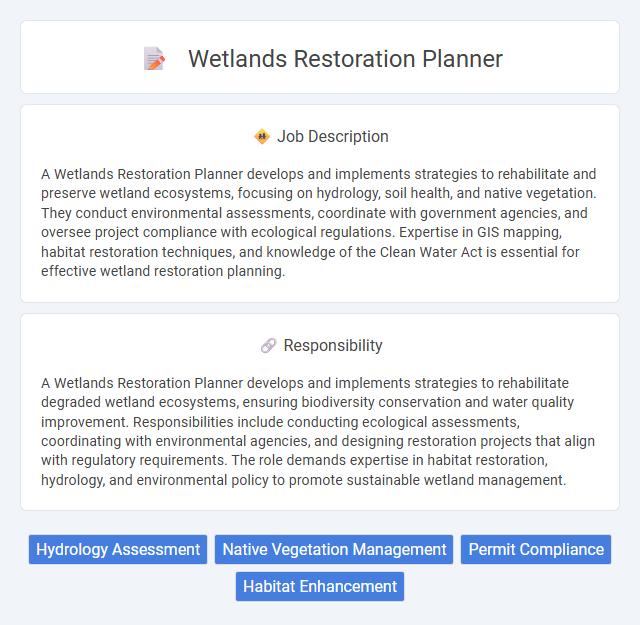
A Wetlands Restoration Planner develops and implements strategies to rehabilitate and preserve wetland ecosystems, focusing on hydrology, soil health, and native vegetation. They conduct environmental assessments, coordinate with government agencies, and oversee project compliance with ecological regulations. Expertise in GIS mapping, habitat restoration techniques, and knowledge of the Clean Water Act is essential for effective wetland restoration planning.
Individuals with a strong passion for environmental conservation and experience in ecological management are likely suitable for a Wetlands Restoration Planner role. Those possessing skills in data analysis, project coordination, and community engagement may find themselves well-prepared to handle the complexities of wetland ecosystems and restoration projects. Candidates with limited knowledge of environmental science or poor collaboration skills might face challenges adapting to the demands of this position.
Qualification
A Wetlands Restoration Planner typically requires a bachelor's degree in environmental science, ecology, or related fields, with advanced knowledge in hydrology, soil science, and native vegetation management. Proficiency in Geographic Information Systems (GIS), environmental regulations, and project management is essential for designing and implementing effective restoration strategies. Relevant certifications, such as Certified Ecological Restoration Practitioner (CERP), and experience with wetland assessment protocols further enhance qualification and career prospects.
Responsibility
A Wetlands Restoration Planner develops and implements strategies to rehabilitate degraded wetland ecosystems, ensuring biodiversity conservation and water quality improvement. Responsibilities include conducting ecological assessments, coordinating with environmental agencies, and designing restoration projects that align with regulatory requirements. The role demands expertise in habitat restoration, hydrology, and environmental policy to promote sustainable wetland management.
Benefit
Wetlands restoration planners are likely to enhance biodiversity by designing projects that revive native habitats and support endangered species. This role probably contributes to improved water quality and flood control through the rehabilitation of natural wetland functions. Employers may see increased community engagement and stronger environmental compliance as additional benefits of effective restoration planning.
Challenge
Wetlands restoration planners likely face the challenge of balancing ecological preservation with human development demands, which may complicate project goals. Limited funding and variable climate conditions could also hinder the successful implementation of restoration efforts. Navigating regulatory requirements and engaging stakeholders presents an additional layer of complexity in effective wetlands management.
Career Advancement
A Wetlands Restoration Planner develops strategic plans to rehabilitate and conserve critical wetland ecosystems, leveraging expertise in environmental science and regulatory compliance. Career advancement in this field often involves progressing to senior environmental consultant, project manager, or ecological restoration specialist roles, with opportunities to influence large-scale conservation projects and policy development. Enhancing skills in GIS mapping, environmental impact assessment, and project management increases prospects for leadership positions and higher salary brackets within government agencies, NGOs, and environmental consulting firms.
Key Terms
Hydrology Assessment
Wetlands restoration planners specialize in hydrology assessment to evaluate water flow, groundwater levels, and seasonal variations critical for wetland ecosystems. They analyze hydrological data to design restoration projects that enhance water retention, improve flood control, and support native vegetation. Proficiency in GIS mapping, hydrological modeling software, and wetland regulatory frameworks ensures effective planning and sustainable wetland rehabilitation.
Native Vegetation Management
A Wetlands Restoration Planner specializing in Native Vegetation Management designs and implements strategies to rehabilitate wetland ecosystems by promoting indigenous plant species that enhance biodiversity and stabilize soil. Expertise in ecological assessments, hydrological modeling, and native flora propagation ensures effective restoration outcomes aligned with conservation goals. Collaboration with environmental agencies and use of GIS technology support precise planning and monitoring of native vegetation recovery in wetland habitats.
Permit Compliance
Wetlands restoration planners specialize in designing and implementing projects that rehabilitate and conserve wetland ecosystems while ensuring strict adherence to environmental regulations. They manage permit compliance by coordinating with agencies such as the U.S. Army Corps of Engineers and the Environmental Protection Agency to secure necessary permits under the Clean Water Act Section 404 and monitor ongoing project impacts. Expertise in wetlands delineation, environmental impact assessments, and mitigation strategies is essential for maintaining regulatory standards and promoting sustainable restoration outcomes.
Habitat Enhancement
A Wetlands Restoration Planner specializes in designing and implementing projects that enhance wetland habitats to support biodiversity and ecosystem health. Their work involves assessing hydrology, native vegetation, and soil conditions to restore natural functions and improve wildlife corridors. Expertise in federal and state environmental regulations ensures that habitat enhancement aligns with conservation goals and sustainable resource management.
 kuljobs.com
kuljobs.com